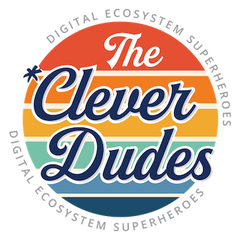Customer Relationship Management
Posted by THE CLEVER DUDES ADMIN

CRM isn’t a new thing however it is largely unexplored or under-utilised in the SME sector. Over the past few years, CRM software has become more accessible to smaller companies however the associated costs have caused the would be users to shy away from making use of anything worthy investment.
Historically CRM systems were custom built by technical geniuses exclusively for a specific client. Now the technical geniuses have been snapped up by the SAAS (System as a Service) companies and made good CRM applications available to the masses.
Sure there’s still a lot of them that are mostly marketing automation (email) service providers with some basic CRM functionality and whilst that can work, by spending a little more your returns can be a whole lot higher.
Consider the following scenarios:
a) You have your own brand
b) You’re selling products you’re passionate about
c) You’re selling online because of the passive income potential
d) You’re new to the digital realm but need to start selling online ASAP because the high street is reserved for the rich, the famous and the show-offs – basically you can’t afford the rent
If any, or all of the above are applicable then understanding your customers, their shopping habits and what makes them part with their hard earned cash is the key to you earning their loyal spending.
Understanding your customers is an ongoing task. Some people’s favourite colour changes every week. Others don’t even have a favourite colour. The point is, individuals, groups, clans, tribes every person that has ever interacted with your brand, all have different thoughts, perceptions, ideologies and for a multitude of reasons. Now the best way of knowing is to ask, and this is why surveys exist, however collecting data over a period of time based on purchase history, social media content engagement and search terms for example give us insight into trends and allow us to gradually develop more targeted and specific campaigns. So what does this mean? Advertising on social media for example is a good start.
Usually, first timers just select the region and interests and away they go, with one ad. As we develop a better understanding of who our customers are, what they like, what content receives the most engagement and which of those engaged leads end up converting into paying customers, we’re able to develop campaigns with multiple ads (and the key being multiple because we now understand that different customers want different things. Let’s compare some stats between the different campaigns.

As you can see from Campaign 2: Ad 3, despite the having the lowest number of impressions, it has the highest conversion rate. In summary, this means spend less and earn more.
But there is more to CRM than simply the marketing opportunities. With efficient data accessibility, you would be able to offer a higher level of customer service. Real time updates means that customer info is always recent and most importantly, it’s relative. You will instantly be able to refer to a most recent conversion your customer has with anyone in your company, the most recent email they received, if they read your marketing email and if they eventually ended up buying on your website as a result.
A good CRM system can be an extremely formidable tool and can be the significant competitive advantage you have been looking for.

